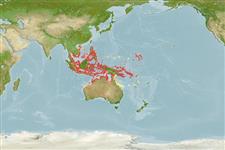>
Eupercaria/misc (Various families in series Eupercaria) >
Labridae (Wrasses)
Etymology: Diproctacanthus: Greek, di = two + Greek, proktos = anus + Greek, akantha = thorn (Ref. 45335).
More on author: Bleeker.
Environment: milieu / climate zone / depth range / distribution range
Οικολογία
Θαλασσινό(ά) Υφαλόφιλο(α); εύρος βάθους 2 - 25 m (Ref. 90102), usually 2 - 20 m (Ref. 27115). Tropical; 24°C - 28°C (Ref. 27115); 19°N - 25°S, 99°E - 172°E
Western Central Pacific: Philippines, Palau, Indonesia, New Guinea, and Great Barrier Reef.
Μέγεθος / Βάρος / Age
Maturity: Lm ? range ? - ? cm
Max length : 10.0 cm TL αρσενικό/απροσδιόριστο; (Ref. 6023)
Short description
Κλείδες προσδιορισμού | Μορφολογία | Μορφομετρία
Ραχιαίες άκανθες (συνολικά) : 9; Μαλακές ραχιαίες ακτίνες (συνολικά) : 9 - 10; Εδρικές άκανθες: 2; Μαλακές εδρικές ακτίνες: 9 - 11; Σπόνδυλοι: 25. Juveniles with 3 broad black stripes from head to caudal fin where the stripes merge; with growth, lower stripe disappears, upper stripe is less distinct; black caudal fin becomes entirely yellow in adults. Head scales small. Lips thick and fleshy, forming a short tube when mouth is closed. Caudal fin rounded to truncate; pelvic fins rounded.
A solitary species (Ref. 90102) occurring in coral rich areas of shallow lagoons and sheltered seaward reefs. Adults feed mainly on coral polyps while juveniles remove ectoparasites from small territorial fishes (Ref. 2334, 9710). Adults swim in small groups. Usually, only small juveniles clean other fishes (Ref. 48636).
Life cycle and mating behavior
Maturities | Αναπαραγωγή | Spawnings | Egg(s) | Fecundities | Προνύμφες
Oviparous, distinct pairing during breeding (Ref. 205).
Randall, J.E., G.R. Allen and R.C. Steene, 1990. Fishes of the Great Barrier Reef and Coral Sea. University of Hawaii Press, Honolulu, Hawaii. 506 p. (Ref. 2334)
IUCN Red List Status (Ref. 130435)
Threat to humans
Harmless
Human uses
αλιεία: Εμπορικό(ά); Ενυδρείο: Εμπορικό(ά)
Εργαλεία
Special reports
Download XML
Διαδικτυακές πηγές
Estimates based on models
Preferred temperature (Ref.
123201): 26.8 - 29, mean 28.2 °C (based on 610 cells).
Phylogenetic diversity index (Ref.
82804): PD
50 = 1.0000 [Uniqueness, from 0.5 = low to 2.0 = high].
Bayesian length-weight: a=0.00912 (0.00466 - 0.01787), b=3.06 (2.89 - 3.23), in cm total length, based on LWR estimates for this species & (Sub)family-body (Ref.
93245).
Τροφικό Επίπεδο (Ref.
69278): 3.3 ±0.61 se; based on food items.
Ελαστικότητα (Ref.
120179): Υψηλό, ελάχιστος χρόνος για διπλασιασμό πληθυσμού < 15 μήνες (Preliminary K or Fecundity.).
Fishing Vulnerability (Ref.
59153): Low vulnerability (10 of 100).
Nutrients (Ref.
124155): Calcium = 121 [70, 214] mg/100g; Iron = 0.854 [0.488, 1.603] mg/100g; Protein = 18.3 [15.5, 20.6] %; Omega3 = 0.162 [0.099, 0.263] g/100g; Selenium = 22.3 [12.7, 40.8] μg/100g; VitaminA = 154 [47, 580] μg/100g; Zinc = 2.07 [1.39, 3.30] mg/100g (wet weight);
